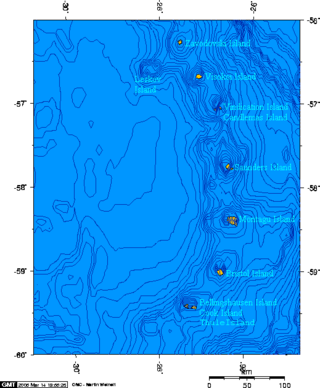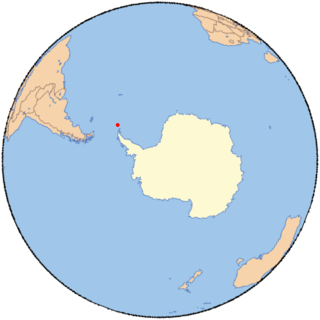Related Research Articles

Mount Terror is an extinct volcano about 3,230 metres (10,600 ft) high on Ross Island, Antarctica, about 20 nautical miles eastward of Mount Erebus. Mount Terror was named in 1841 by polar explorer Sir James Clark Ross for his second ship, HMS Terror. The captain of Terror was Francis Crozier, a close friend of Ross for whom the nearby Cape Crozier is named.

Cook Island is the central and largest island of the Southern Thule island group, part of the South Sandwich Islands in the far south Atlantic Ocean. Southern Thule was discovered by a British expedition under Captain James Cook in 1775. Cook Island was named for Cook by a Russian expedition under Fabian Gottlieb von Bellingshausen, which explored the South Sandwich islands in 1819–1820.

Annenkov Island is an island in South Georgia and the South Sandwich Islands, to the west of the main island of South Georgia. The Pickersgill Islands are to its southeast. It is irregularly shaped and 4 miles (6.4 km) long and 650 m (2,130 ft) high, lying 8 miles (13 km) off the south-central coast of South Georgia.

Thatcher Peninsula is a mountainous peninsula in north-central South Georgia. Its total area is approximately 5,640 hectares, with roughly 1,620 ha covered in vegetation. It terminates to the north in Mai Point, rising between Cumberland West Bay to the west, and Cumberland East Bay and Moraine Fjord to the east. It is bounded to the southwest and south by Lyell Glacier and Hamberg Glacier. King Edward Cove on the east side of the peninsula is the site of the British Antarctic Survey (BAS) Grytviken station and the disused whaling station of the same name.
The Kyle Hills are a prominent group of volcanic cones, hills, ridges, and peaks that occupy the eastern part of Ross Island, Antarctica, between Mount Terror and Cape Crozier. The hills extend east–west for 8 nautical miles (15 km), rising from sea level at Cape Crozier to about 2,600 metres (8,500 ft) in Mount McIntosh at the western end of the group. Local relief of features is on the order of 200 metres (660 ft).
Mount Newall is a peak, 1,920 metres (6,300 ft) high, the northeast extremity of Asgard Range, in Victoria Land, Antarctica. It was discovered by the Discovery Expedition (1901–04) and named for one of the men who helped raise funds to send a relief ship for the expedition.

Caraquet Rock is a rock lying nearly 4 nautical miles (7 km) west-southwest of Bell Point, off the west part of King George Island in the South Shetland Islands. It was named by the UK Antarctic Place-Names Committee in 1960 for the sealing vessel Caraquet from Liverpool, which visited the South Shetland Islands in 1821–22.

Cooper Snowfield is a snowfield with an area of about 25 square miles (65 km2) in the Churchill Mountains of Antarctica.

Guerrero Glacier is a glacier about 7 nautical miles (13 km) long in Doyran Heights, draining from the southeast slopes of Mount Havener southwest of Beloslav Peak to the south side of Taylor Spur, in the southeast part of the Sentinel Range, Ellsworth Mountains, Antarctica. It was first mapped by the United States Geological Survey from surveys and U.S. Navy air photos, 1957–59, and was named by the Advisory Committee on Antarctic Names for John F. Guerrero, a meteorologist at South Pole Station in 1957.

Grey Island is 1 km (0.62 mi) south of Michelsen Island and 2 km (1.2 mi) west of the southern part of Fredriksen Island, in the South Orkney Islands of Antarctica. It was first charted and named Holmen Graa on a map by the Norwegian whaler Captain Petter Sorlle, who made a running survey of the South Orkney Islands in 1912–13. The anglicised form appears on the chart by Discovery Investigations personnel on the Discovery II who surveyed the islands in 1933.
Péwé Peak is a bedrock peak, 860 metres (2,820 ft) high, composed of granite and topped with a dolerite sill. The peak is immediately south of Joyce Glacier and is surrounded by glacial ice except on the south side. It was named by the Advisory Committee on Antarctic Names for Troy L. Péwé, a glacial geologist with U.S. Navy Operation Deep Freeze, 1957–58, who personally explored this peak as well as adjacent portions of Victoria Land.
Hardy Point is the western point of Bellingshausen Island in the South Sandwich Islands. It was charted in 1930 by Discovery Investigations personnel on the Discovery II, who named it for Alister C. Hardy, a member of the zoological staff of the Discovery Committee, 1924–28, and professor of zoology at University College Hull.
McCollum Peak is a peak, 735 metres (2,410 ft) high, standing south of Beascochea Bay 2 nautical miles (4 km) southeast of Mount Waugh, on the west coast of Graham Land, Antarctica. It was first charted by the Fourth French Antarctic Expedition under Jean-Baptiste Charcot, 1908–10, and was named by the UK Antarctic Place-Names Committee in 1959 for Elmer V. McCollum, an American biochemist who first isolated vitamins A and B, in 1915.
Hessler Peak is a sharp peak, 1,670 metres (5,480 ft) high, at the south end of Dunbar Ridge in the Heritage Range in Antarctica. It was mapped by the United States Geological Survey from surveys and U.S. Navy air photos from 1961 to 1966, and was named by the Advisory Committee on Antarctic Names for Victor P. Hessler, an ionosphere physicist and United States Antarctic Research Program scientist at the Soviet Vostok Station in the 1965–66 and 1966–67 summer seasons.
Hunt Peak is a triangular rock peak, 610 metres (2,000 ft) high, marking the north side of the entrance to Stonehouse Bay on the east coast of Adelaide Island, Antarctica. It was discovered and first roughly surveyed in 1909 by the French Antarctic Expedition under Jean-Baptiste Charcot. It was resurveyed in 1948 by the Falkland Islands Dependencies Survey (FIDS), who named the point marked by this peak for Sergeant Kenneth D. Hunt, a mechanic for the expedition's Noorduyn Norseman airplane in 1950. Further survey in 1957–58 by the FIDS showed no definable point in the vicinity and the name was transferred to the peak.
Maurice Channel is a strait 1.5 nautical miles (3 km) wide between Bellingshausen Island and Cook Island, in the South Sandwich Islands off Antarctica. In 1820, Fabian Gottlieb von Bellingshausen indirectly indicated the existence of the strait by describing Southern Thule as consisting of one high rock and three small islands. The strait was charted in 1930 by Discovery Investigations personnel on the Discovery II and named for Henry Gascoyne Maurice, a member of the Discovery Committee.
Mount Hopeful is a peak standing 1.5 nautical miles (3 km) north of the head of King George Bay and 1.5 nautical miles southeast of Rea Peak on King George Island, in the South Shetland Islands. It was named by the UK Antarctic Place-Names Committee in 1960 for the Enderby Brothers' schooner Hopeful, which sailed from London in 1833 in company with the tender Rose in order to continue John Biscoe's Antarctic researches. The Antarctic voyage was abandoned after the Rose had been crushed in the pack ice at 60°17′S53°26′W in December 1833 or January 1834.

Hough Glacier is a glacier in central Doyran Heights in the Sentinel Range of Ellsworth Mountains, Antarctica, rising just south of Mount Tuck and flowing east-southeast for 10 nautical miles between Guerrero Glacier and Remington Glacier. It was first mapped by the United States Geological Survey from surveys and U.S. Navy air photos, 1957–59, and was named by the Advisory Committee on Antarctic Names for William S. Hough, who made ionosphere studies at South Pole Station in 1957.

Bristol Island is an uninhabited island in the South Sandwich Islands, an archipelago in the Southern Ocean. The island is almost entirely surrounded by ice cliffs and largely covered with ice. It features both the oldest rocks of this archipelago and an active volcano that last erupted in 2016.
References
- ↑ "Havfruen Peak". Geographic Names Information System . United States Geological Survey, United States Department of the Interior . Retrieved 31 May 2012.
- ↑ Alberts, Fred G., ed. (June 1995). Geographic Names of the Antarctic (PDF) (second ed.). United States Board on Geographic Names. p. 319. Retrieved 5 April 2012.
![]() This article incorporates public domain material from "Havfruen Peak". Geographic Names Information System . United States Geological Survey.
This article incorporates public domain material from "Havfruen Peak". Geographic Names Information System . United States Geological Survey.